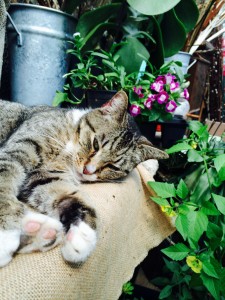Finding flowers that will perform in Birmingham’s brutal summer heat and humidity is an ongoing challenge. Fortunately, we’ve found many that will do well…and thrive if given the right care. In a post from last summer, I highlighted a few summer annuals, and here’s an update.
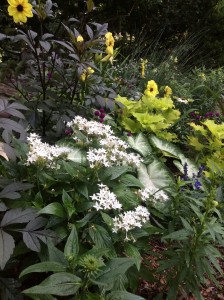
A white penta in the garden…
Have you tried pentas? They are flower dynamos and butterfly magnets. I make sure to add them to my garden each year, knowing that, come the dog days of August, they’ll be hitting their stride. All they ask for is periodic deadheading to keep blooms coming and supplemental water if we go through summer dry spells. Available in a wide range of colors – white, red, pinks and lavenders – they add a rounded, star-cluster flower form to the garden.
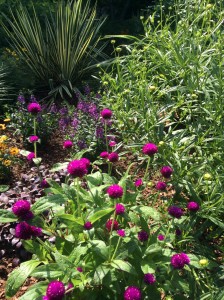
Tall purple gomphrena
In last year’s post I highlighted gomphrena, and it’s getting an encore mention this year because I like it so much. The tall ones are my favorite, though they’ve been hard to come by this year. I’ve finally been able to find a tall purple one, though, and will be putting it in planters and recommending it to everyone for sunny, hot spots in the garden. The tall stems with rounded globe-like flowers, like the pentas, add another interesting flower shape to any flower bed.
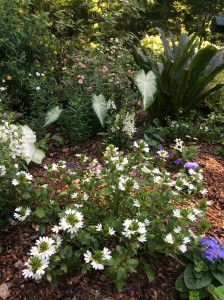
Fanflower…
Finally, here are two low-growing plants that can be used to spill out of containers or as a groundcover in garden beds. First, one I use all the time in containers and in the ground is scaevola, or fan flower (See the “fans”?). You’ve probably seen the blue/purple selections, but there is also a white form shown here, as well as pink, a purple and white, and a yellow.
It’s interesting fan-shaped flowers are held on stems that in containers get quite long. Because of this, it will benefit from being cut back at times through the summer. You can either cut the whole plant back when it gets leggy, or you might choose to just cut a few of the longest stems back here and there. This won’t hurt it at all, so don’t be afraid to do this!
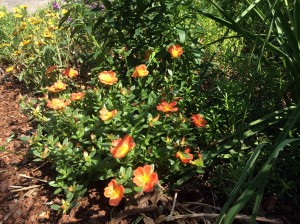
Purslane, just beginning to bloom…
Last, but definitely not least, as far as heat tolerance and toughness, and loved by honeybees too, is purslane. This little flowering succulent has been improved upon by hybridizers over the years. These improved varieties offer vivid colors from white to many shades of oranges, pinks, and reds. The flowers will close in the late afternoon, but do they make up for it the rest of the day!
New varieties have larger blooms on heat and drought tolerant plants, making them a definite winner in my book. Try them either mixed with other succulents in a container, trailing from a hanging basket, or in the ground, perhaps along a hot sidewalk or driveway.
So, while we struggle through the summer heat and humidity of the south, it’s nice to know our gardens and containers don’t have to. It’s all in finding the right plants for your tough spots and knowing what to do to keep them looking their best!
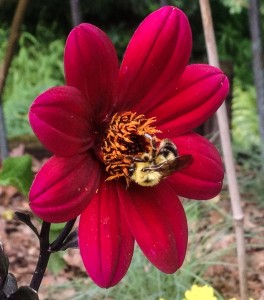 Neonicotinoides…a long word and one you may not be familiar with. However, it describes a class of chemicals found in many of the garden products you may have in your garage right now. We want to give you more information about this because, even though they’ve been approved by the EPA, independent studies have found links between these systemic insecticides and harm to honeybees, with research suggesting these chemicals may make honeybees more susceptible to parasites and pathogens. These chemicals work systemically, that is, being taken up through the roots of various plants you may be spraying or applying granular products to. We hope the links below will be helpful in your understanding of this issue.
Neonicotinoides…a long word and one you may not be familiar with. However, it describes a class of chemicals found in many of the garden products you may have in your garage right now. We want to give you more information about this because, even though they’ve been approved by the EPA, independent studies have found links between these systemic insecticides and harm to honeybees, with research suggesting these chemicals may make honeybees more susceptible to parasites and pathogens. These chemicals work systemically, that is, being taken up through the roots of various plants you may be spraying or applying granular products to. We hope the links below will be helpful in your understanding of this issue.
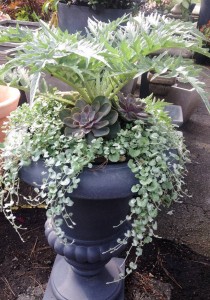
 The next uses a red fountain grass for height in a tall planter with the addition of white Profusion zinnias and white euphorbia as fillers. Spilling out are blue daze and potato vine. This planting will bloom continuously with regular water and periodic deadheading or clipping back of the zinnias. Late in the summer the grass will begin to bloom for an end of the season finale.
The next uses a red fountain grass for height in a tall planter with the addition of white Profusion zinnias and white euphorbia as fillers. Spilling out are blue daze and potato vine. This planting will bloom continuously with regular water and periodic deadheading or clipping back of the zinnias. Late in the summer the grass will begin to bloom for an end of the season finale.
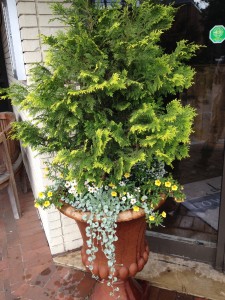 Many of you have pots that have shrubs in them that live year round, and just need some color added each season. In this example, the Chamaecyparis adds yellow foliage and is complimented through the summer with yellow million bells, white narrow leaf zinnias, silver dichondra and some euphorbia. The million bells and zinnias will be cut back when they get too leggy (There’s no need to deadhead each individual bloom on these.) and it will be watered daily, since the Chamaecyparis has been in this planter for a few years and it’s roots are filling the planter quite extensively.
Many of you have pots that have shrubs in them that live year round, and just need some color added each season. In this example, the Chamaecyparis adds yellow foliage and is complimented through the summer with yellow million bells, white narrow leaf zinnias, silver dichondra and some euphorbia. The million bells and zinnias will be cut back when they get too leggy (There’s no need to deadhead each individual bloom on these.) and it will be watered daily, since the Chamaecyparis has been in this planter for a few years and it’s roots are filling the planter quite extensively.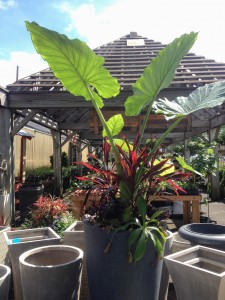 The final planting uses a dramatic, and very large Alocasia – this speaks for itself, though it has supporting players as well, including dracaena, epescia, nepenthes, and alternanthera. It’s quite a combo.
The final planting uses a dramatic, and very large Alocasia – this speaks for itself, though it has supporting players as well, including dracaena, epescia, nepenthes, and alternanthera. It’s quite a combo.

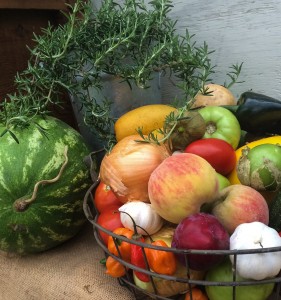

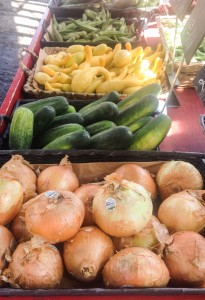
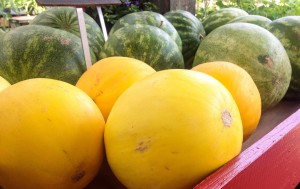

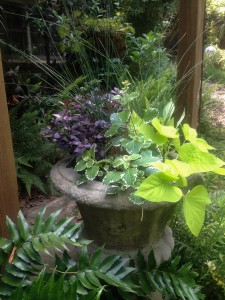
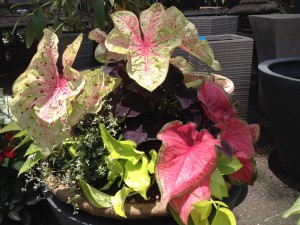
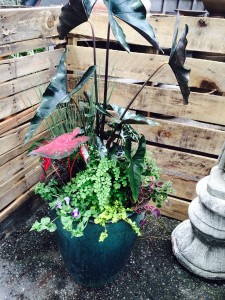 Sometimes it’s fun to try a plant that’s more unusual as the centerpiece of a design. In this glazed pot the dark leaf of the Alocasia is a beautiful contrast to the coleus, grasslike juncus, maidenhair fern, trailing torenia, and creeping jenny.
Sometimes it’s fun to try a plant that’s more unusual as the centerpiece of a design. In this glazed pot the dark leaf of the Alocasia is a beautiful contrast to the coleus, grasslike juncus, maidenhair fern, trailing torenia, and creeping jenny.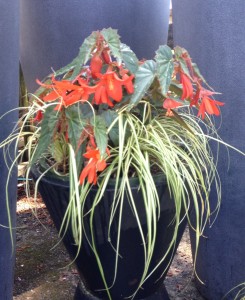 Finally, here’s a simple planting for shade using a begonia and the contrasting leaf and brightness of carex ‘Evergold’, which will spill over the edge of the container. Simple, yet effective. The begonia will continue to bloom with a couple of cutbacks if it gets “leggy.”
Finally, here’s a simple planting for shade using a begonia and the contrasting leaf and brightness of carex ‘Evergold’, which will spill over the edge of the container. Simple, yet effective. The begonia will continue to bloom with a couple of cutbacks if it gets “leggy.”






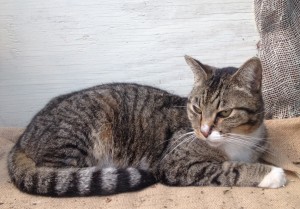 For now she’s quite content just to be with us in the back of the greenhouse, watching us work and receiving the occasional pet or hug. She’s not sure about Ozzie, greeting him with hisses and growls; but we’re certain they”ll work it out, and we’re giving Ozzie plenty of extra attention!
For now she’s quite content just to be with us in the back of the greenhouse, watching us work and receiving the occasional pet or hug. She’s not sure about Ozzie, greeting him with hisses and growls; but we’re certain they”ll work it out, and we’re giving Ozzie plenty of extra attention!